[Review] Jurassic World Evolution: Complete Edition – Nintendo Switch
Jurassic World Evolution: Complete Edition
Nintendo Switch
Developed By: Frontier
Published By: Frontier
Category: Simulation, Strategy
Release Date: 11.03.20
I don’t know when exactly, but somewhere along the way movie tie-in games stopped being almost universally cheap cash grabs. I mean, sure, some still are, but a lot end up like today’s entry: Jurassic World Evolution: Complete Edition for the Nintendo Switch. Maybe it’s not the most original game on the planet, but it does an excellent job adapting its source material in a genre that maybe isn’t the most natural sell for most licensors. Given the franchise, however, an amusement park management sim isn’t actually much of a stretch. Maybe it’s a tad less suspenseful than the movies, but Jurassic World Evolution never lets that hold it back from being an enjoyable experience.
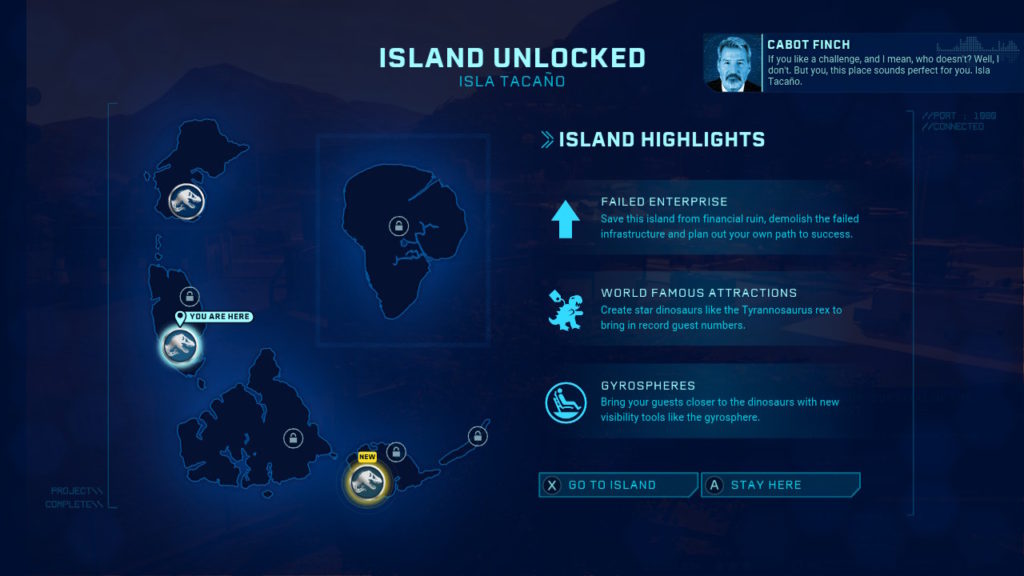
With This Many Dinosaurs, You’d Think There Would Be More Than Five Deaths
Jurassic World Evolution: Complete Edition was first released on the PC a couple years ago. It tasks players with taking command of the Jurassic Park complexes on the five islands of the Cinco Muertes Archipelago. Why tempt fate by having a park with such a high fatality rate on islands known as the five deaths? Well, no one in the franchise’s history seems to understand that cloning dinosaurs always seems to end in horrible death tolls, so why would they learn now? Plus it’s where the books and movies take place, so I guess park ownership’s inability to comprehend heavy-handed foreshadowing persists across all media.
ANYWAY, the game boasts more than a common setting with the movies; it has some characters make the leap as well. The actors playing them don’t, which is to be expected. Most of the voice actors don’t really sound that much like their movie counterparts, but I have to say whoever does Dr. Ian Malcolm does a pretty darn good Jeff Goldblum. Not perfect, but pretty good. Mostly they chime in with commentary during tutorials, after certain milestones, or during various missions.
You may have noticed they called it the “Complete Edition,” which as seasoned gamers will know means that this version of the game comes with all of the additional content that had to be purchased separately on other platforms. There are three narrative mission packs: The Secrets of Dr. Wu missions are integrated into the regular campaign mode, but Return to Jurassic Park and Claire’s Sanctuary actually have their own campaign option in the menu. You also get a skin pack for your velociraptors, and four dinosaur packs that drive the total number of dinos up to 60. Even if the game was total crap (it’s not, it’s actually quite good), they’re not skimping on the content.
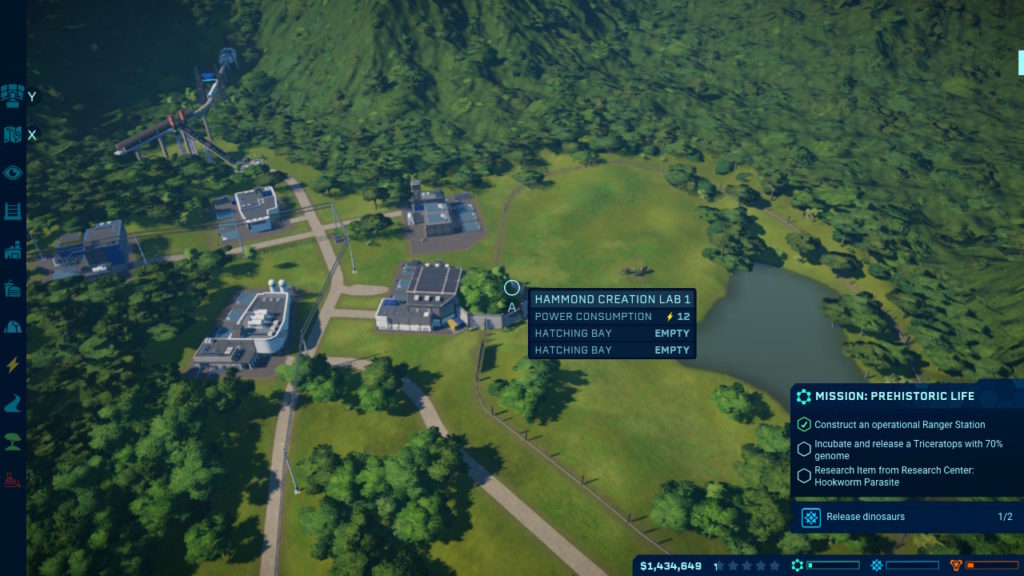
Campaigning For Missions in the Sandbox
JWE features three different game modes, and while they all play the same, they feature different objectives and structures. First, and most intensive, we’ve got the campaign mode. The base campaign starts with the tutorial on the first of the Cinco Muertas islands. The more you improve an island, the higher its rating – they go from one to five stars. Once you get to three stars, the next island opens up to be played. Each new island introduces new complications to running your park; some have weather patterns which damage your park and some have climates that just aren’t very friendly for dinosaurs. Each island feels just distinct enough to feel worth adding, but the variety of the game based on the island location is a little thin.
Luckily, the campaign doesn’t just stop there when it comes to giving you something new to do on each new island. The company that runs the park has a Science, Entertainment, and Security department. They will offer you contracts that you can complete in exchange for money and unlocking new upgrades, buildings, and dinosaur types. Completing contracts will also raise your affinity with that department – but in true corporate fashion, professional jealousy demands that the other departments will think less of you if you help someone else. If you raise your affinity high enough, you will unlock that department’s special mission for that island.
The other two modes are mission and sandbox. Mission mode gives you an objective to achieve and a time limit in which to do it; you get graded on how quickly you can attain the goal, and if you get the full five stars you unlock new skins for your dinos, among other rewards. Sandbox mode just lets you sit back, relax, and run your park your way on whichever island you choose. You get contracts like in campaing mode, but no missions. Honestly, the only real difference between campaign mode and sandbox mode is the missions. It’s not that big a deal considering how much content you get with the DLC added in, but without it I’d wonder what the point of including both was.
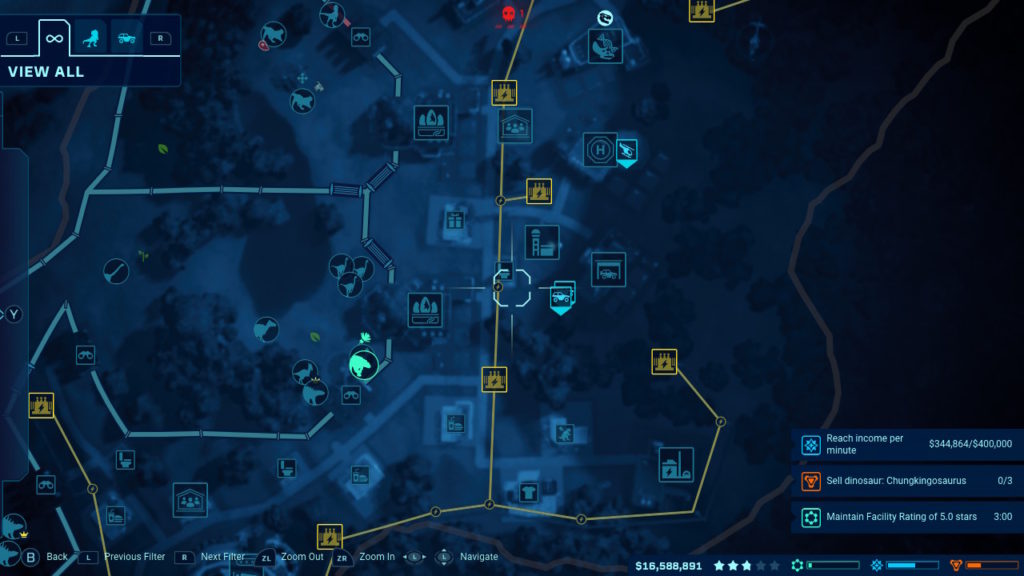
A Scroll Through the Park
Running your park works like it does in most management sims. You get money from ticket sales and hospitality buildings like restaurants, stores, and hotels, which you use to upgrade the park’s capabilities and attractions. You need to balance your profit centers, like stores, with attractions and amenities like making sure people can see your dinosaurs and restrooms. You’ll also need to maintain security and maintenance teams to repair your buildings and corral wayward dinos. So you can’t just focus on making money; the game also tasks you with making sure your guests have a good experience. And at Jurassic Park, a good experience begins and ends with cool dinosaurs.
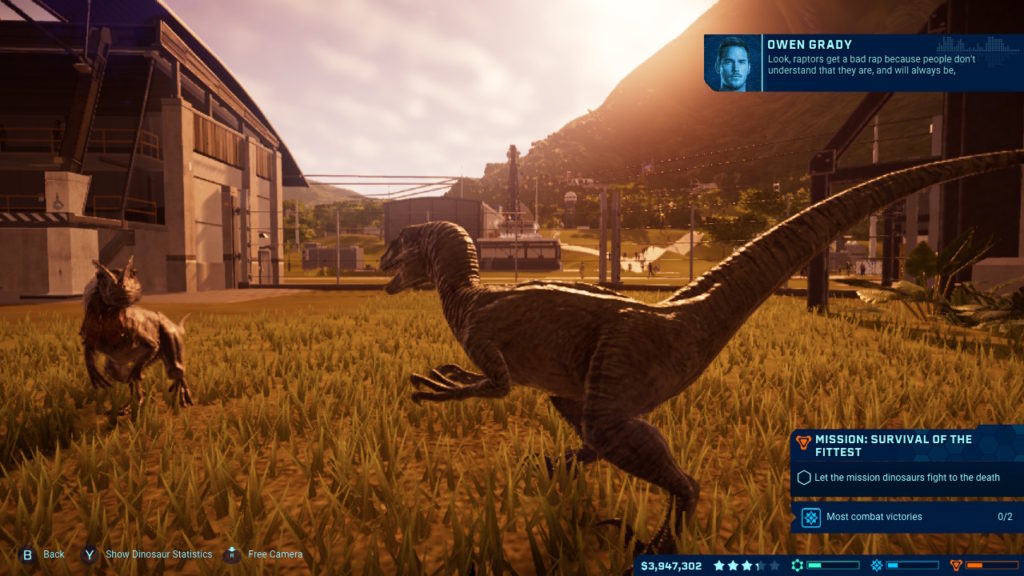
DINOSAURS
Getting your dinos guest-ready is one of the game’s more involved processes. First, you have to have an expedition center which sends dig teams around the world to find dinosaur fossils with dino DNA. Then you have to have a fossil center which analyzes the fossils in an attempt to build each dino species’ genome. You can’t incubate a dino unless you’ve got over 50% of its genome mapped. The higher the percentage of the genome you’ve mapped, the higher the chance of your dino actually being born. If a dinosaur dies before hatching, you just lose that cash you spent incubating it. And it sucks, because growing a dinosaur takes a lot of cash. And the cooler dinosaurs take even more.
And then, once they’re actually born, your dinos need to be kept in enclosures that you can build from a variety of different fences. You can use a regular steel fence for the more docile species, but eventually you can upgrade to electrified and more fortified fence types when you get into the nasty, aggressive breeds. You can build feeders for making sure they get the type of food they need, or you can keep your carnivores in the same enclosure as your herbivores and let nature take its course. Parkgoers love to that dino-on-dino violence, but it can get expensive to keep feeding your T-Rex smaller dinosaurs all the time.
And you can’t just worry about feeding your charges; you’ve also got to account for their different preferences in terrain and climate, as well as their social tendencies. Unhappy dinos charge fences and go after visitors, so keeping your dinosaurs content is just good business. You’ve also got to keep your park rangers and security chopper teams upgraded and ready to deal with various problems. Ranger teams are charged with keeping your feeders full, repairing damaged fences and buildings, and healing sick dinosaurs when they catch a disease. Your choppers are to chase and tranquilize escaped specimens, as well as transporting them once they’re put to sleep. You can also use them to remove dead carcasses from your enclosures to keep rotting bodies from spreading disease.
Luckily, you aren’t completely beholden to your dinosaurs’ natures; you can research genetic modifications for your attractions to change their stats and make them more viable in different climates. You can also make them stronger, tougher, faster, or more or less aggressive depending on what kind of show you want to put on for your guests. Having seen some of these movies, I can say it doesn’t seem like a good idea to engineer an ultra-aggressive, super-strong T-Rex, but to each their own I say.
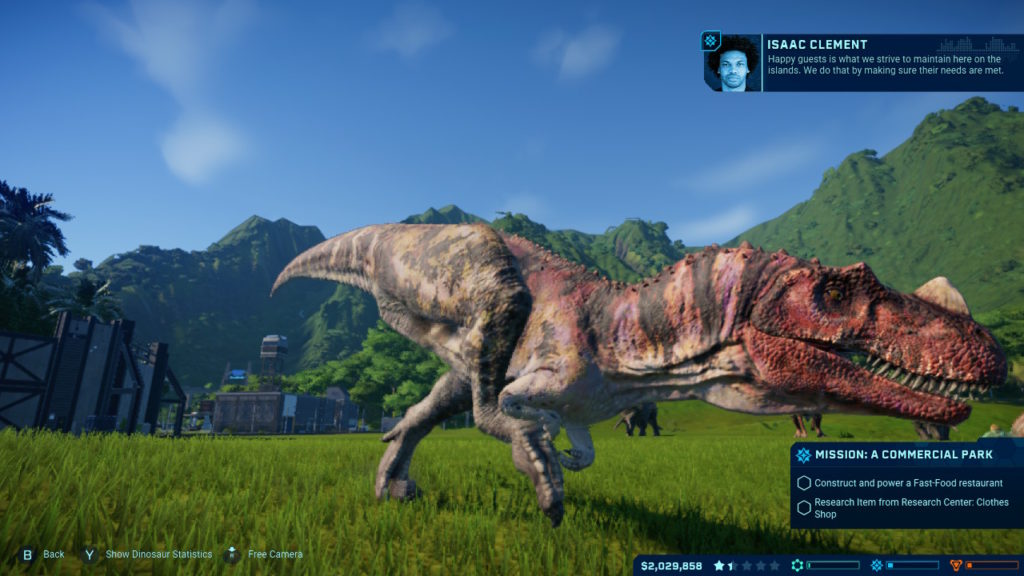
Sightseeing
Graphically, Jurassic World Evolution: Complete Edition works like a lot of games ported to the Switch; the game doesn’t look as good as it does on other platforms, but it’s still good-looking enough when you play it docked. But then, again like a lot of other ports, you lose a lot of visual quality when you take the game off the dock and play handheld. The game gets pretty pixelated on the Switch’s handheld screen, which is kind of a bummer, but these dinos deserve to be seen on a bigger screen anyway. The backgrounds, buildings, and guests all look fine enough, but the dinosaurs look fantastic; detailed, richly textured, and fluidly animated.
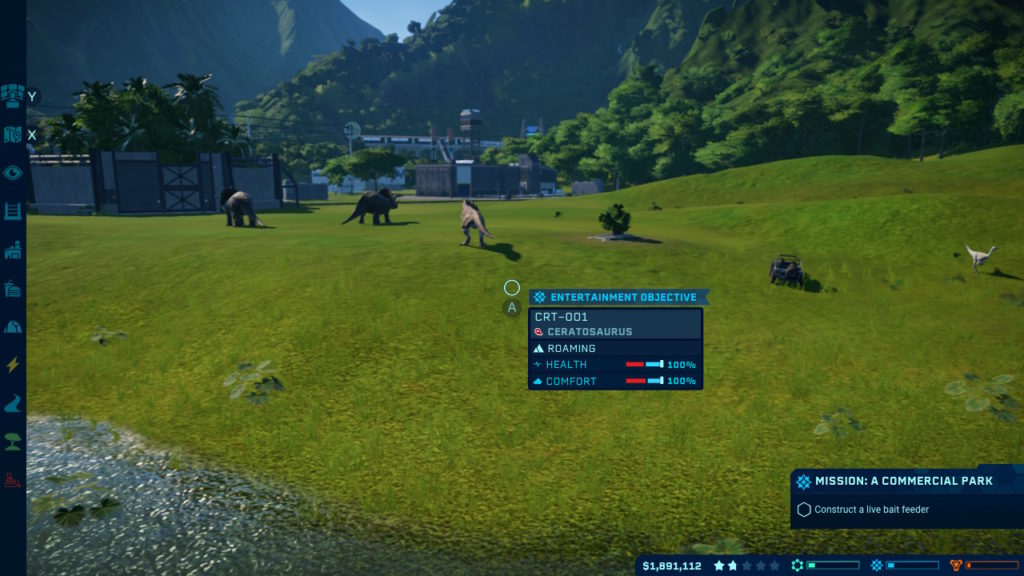
Buy A Ticket
Taken all together, Jurassic World Evolution: Complete Edition is a really fun time. It’s not perfect, but it doesn’t have to be to be enjoyable, either. It’s really cool to see each dinosaur for the first time, or to zoom in and watch them interact with each other in their enclosures. The game’s missions and contracts give you some goals to work towards, which is a nice incentive to keep playing. But the other side of that coin is that once you’ve finished the campaign missions, there’s not a lot of incentive to keep playing. Because once you run out of missions, you realize that the only thing left to do is pretty much just maintaining buildings after they’re damaged in storms or by dino rampages or replacing dead dinosaurs and making them fight and die again. It’s fun for a while, but it’s not totally sustainable. Still, the missions take a good amount of time to complete, there are three whole campaigns to play through, and just unlocking each new island in the first place takes a good investment of time, so you won’t be lacking for playtime. If you love a good management sim, and you want it to have lots of cool dinosaurs, Jurassic World Evolution: Complete Edition should be the first and only place you look.





Buy Jurassic World Evolution: Complete Edition
Digital – $59.99
Follow Frontier


The Switch Effect was graciously supplied a code for review purposes.






